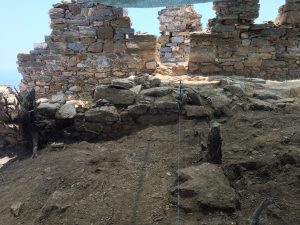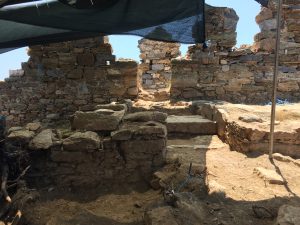It’s time to finally explain what a typical day on site looks like because I don’t just sit around and eat Turkish snacks the entire time (though we do work it into the schedule). So, here’s a quick outline of my day yesterday, Friday, July 20th, 2018…
4:55 a.m. My alarm sounds, I open my eyes just enough to find the snooze button.
5:03 a.m. I and my roommates begin to wake up and will ourselves out of bed.
5:30 a.m. I’m dressed and loaded onto the bus! I’m still not very awake yet.
5:45 a.m. We all stop by the Total gas station, and I purchase a cold 1.5-liter bottle of water and a bag of susamli Çubuk kraker (a.k.a. the best sesame pretzel sticks ever). I’m still trying to wake up since I fell asleep again on the bus.
6:10 a.m. We arrive at the dig depot to eat breakfast. I jump in line for some Turkish tea and sit down to some bread, cheese, jam, and Nutella-like spread. There are also several aggressive wasps swarming the table and we must combat them for some strawberry jam, a shared favorite.
6:45 a.m. To the acropolis! We lather on sunscreen, grab our bags and the elevation equipment, and make our way up.
7:00 a.m. Time to dig.

9 July 2018

16 July 2018
At last, I may introduce my little section, which awaits me at the top of the acropolis. AC6 is a magical place, rather long and on an incline, shaped like a church (we’re quite certain it’s a church), with an apse at the eastern end and a lot of wall fall in between. My team and I have made quite a lot of progress. The site looks completely different from the first day we began working, and our theories and technical skills have evolved accordingly. (See attached pictures.)
Our first major task was to clear the area of dead grass, thorny bushes, and very stubborn tree stumps. We did this for what seemed an eternity – and we’re still clearing and tripping over a few stumps that are buried deep. After the top layer of greenery was removed, we have technically been leveling the ground ever since. Three centimeter peels at a time. Down, down, down. I’ve found some cool stuff along the way – pottery sherds, pieces of glass, nails, and an osteotheke fragment!
Our building is split into two sections, A and B. We didn’t realize it at the time, but the divide conveniently runs a long a wall we recently found which splits the church in two.
Today, I worked in section A (on the eastern side with the apse) and removed a lot of loose rocks and dirt. Moreover, I’ve now reached a burn layer, which I documented on Thursday and took elevation measurements then, too. The soil contains ash and is much darker and finer than that of the surrounding area. The soil is darkest in the southeastern corner of the apse (the fire’s possible origin) and even though I’ve removed a lot of rocks, the burn layer continues underneath. So, I can now assume that the fire occurred before the wall (and roof) collapsed, though there isn’t any way to determine the time in between those two events.
So, on Friday, I worked patiently in my little apse area. Gently breaking up the soil with a pick ax or trowel, scooping up and scanning the soil with a dustpan, placing it in bucket, getting up and emptying the full bucket at the dump site down the cliff … rinse and repeat.
During the course of the morning, I came across an interesting piece of pottery which was dotted with small holes – a type of sieve, perhaps? It was sorted into a small find bag and later processed. I then found another interesting object: a stone fragment with a perfectly carved semi-circle on one side. Professor Howe informed me that it was a loom weight! I’m not terribly sure how it ended up in a fourth-century church, but I will keep that information for future reference.
I also noticed and began collecting several fragments of wall plaster, which was very exciting! Using a bit of water and a tissue, we could see the original red paint, too. But more on that later.
10:00 a.m. I’m still digging when I hear a beautiful sound in the distance – a whistle blow – which signals tea time! We make our way down the hill and cram ourselves in the small shade the ruined Bath walls provide. I happily drank tea and ate pretzel sticks while a few generous souls offered me grapes and chocolate wafer cookies, bless them.
10:30 a.m. The whistle blows again and it’s time to return to my little apse.
10:40 a.m. Dig, scan, repeat until – woah.
11:45 a.m. Along the apsidal wall, I come across the plaster I had been collecting earlier. Except that this time, it was intact and still mortared to the wall, how amazing! This appears to be the original red wall plaster of the 300s AD church. I carefully use a paint brush, water and a tissue to reveal the red paint and take photographs using a color-correcting scale.
11:50 a.m. Julianne plays the song “Closing Time,” by Semisonic, now a cue for everyone to pack up their trowels and label their find bags. We’re ending earlier than normal today for a site tour of other digs at Antiochia ad Cragum where the Turkish students work.
1:00 p.m. Lunchtime! And Fridays are special because Fridays are chicken day – delicious.
2:00 p.m. We load the bus and head down to Pirates Cove for an afternoon swim, also traditional on Fridays.
4:30 p.m. We return to the dig house, tired and happy and maybe a little sunburned. After dinner, my team and I meet to document and describe the work day in our official notebooks.
I hope this better elaborates on the work and routine I’ve developed in the past few weeks. It’s very satisfying to review our progress and see the normal schedule adapt everyday to my team’s new findings and theories!

You must be logged in to post a comment.